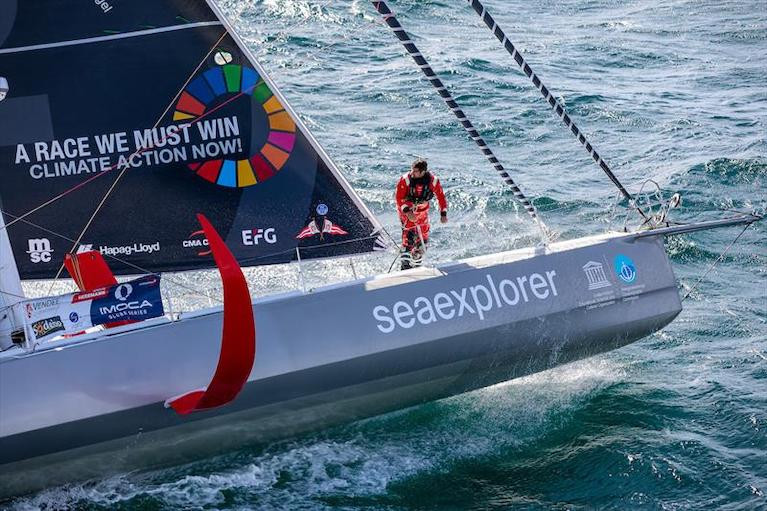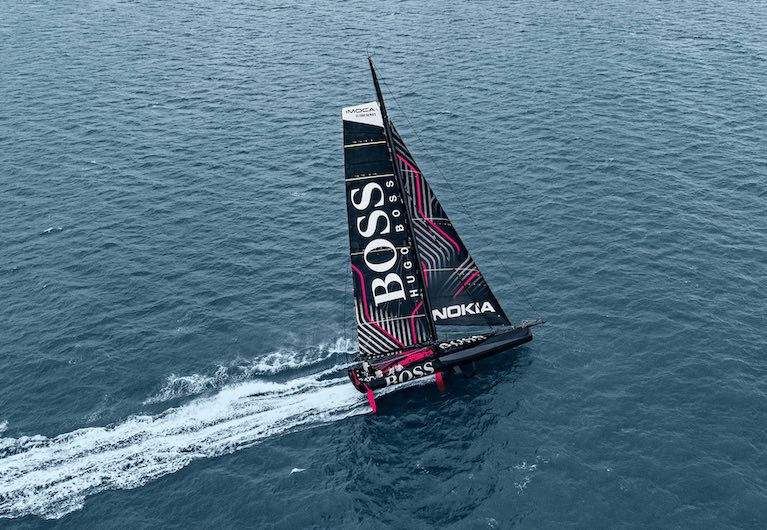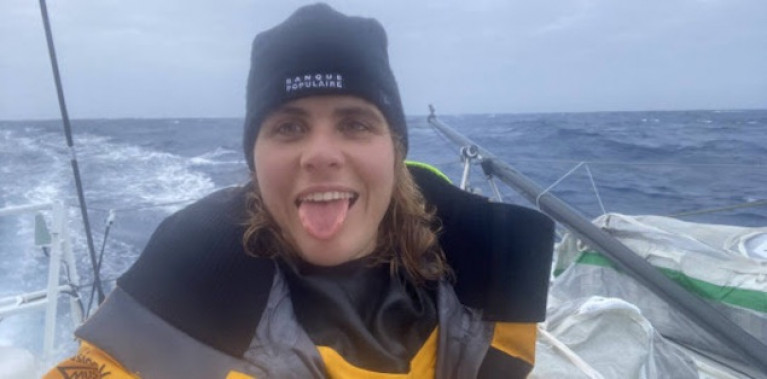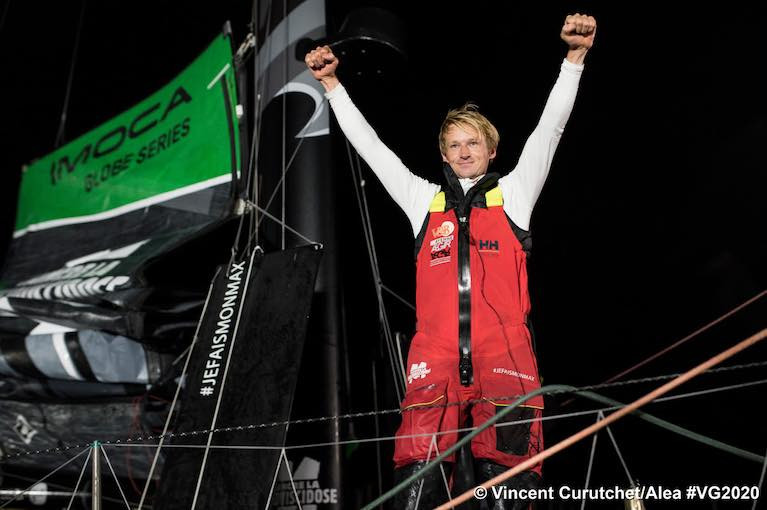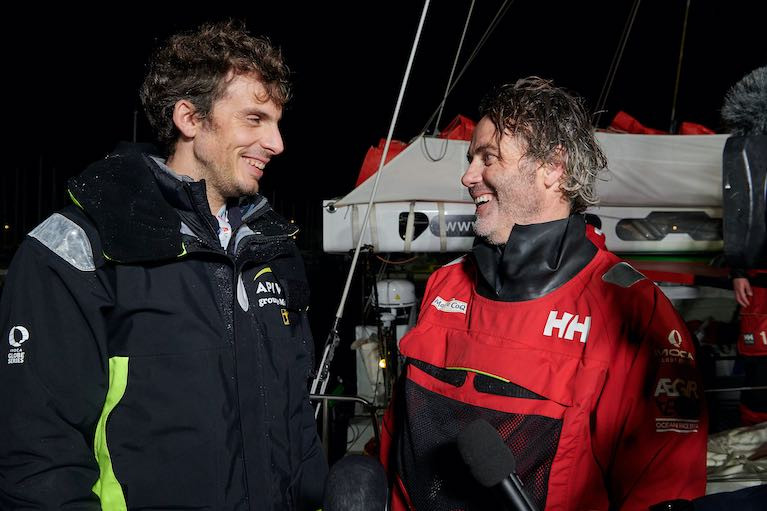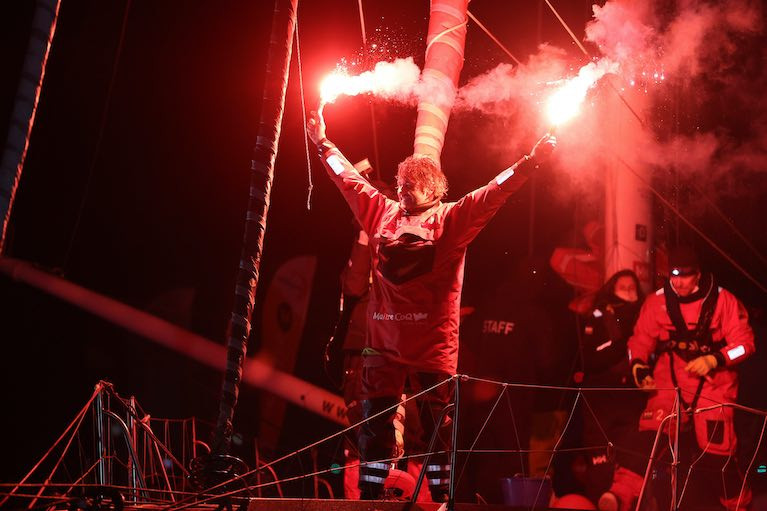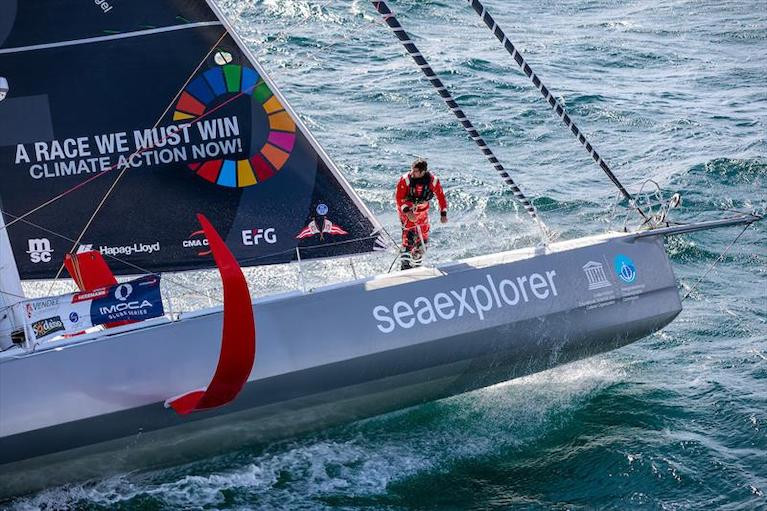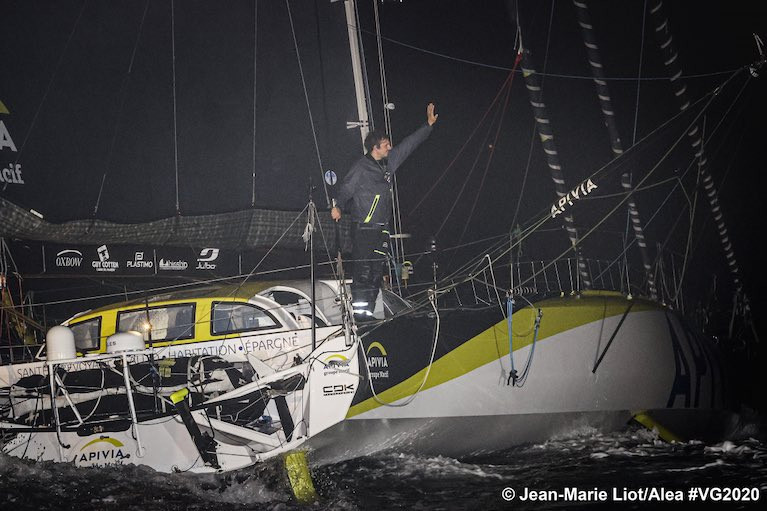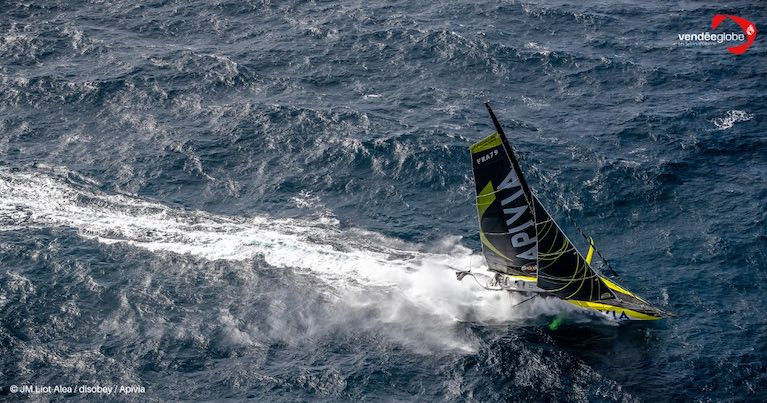Displaying items by tag: Vendee Globe
Pip Hare First British Skipper to Finish the Vendée Globe, Crossing the Line in 19th Place
British solo skipper Pip Hare, 47, fulfilled the dream that she has held since she was a teenage sailor in her native East Anglia, England when she crossed the finish line of the Vendée Globe solo non-stop round the world race at 00:57:30 hrs UTC on the 12th February, emerging from a bitterly cold Bay of Biscay night off Les Sables d’Olonne on the west coast of France to take an excellent 19th place.
After 95 days, 11 hours, 37 mins and 30 seconds of racing, Hare is the first British skipper to finish the 2020-21 race, and only the eighth women ever to finish the Vendée Globe in its history. Her performance on a 21-year-old IMOCA, the oldest boat yet to finish this edition, has drawn admiration from all corners of the world of French and international ocean racing, not just for her high level of motivation and drive throughout the race but for her intelligent, efficient courses and her ability to push her elderly but evergreen boat hard all the way to the finish line.
Pip Hare Vendee Globe Finish Photo Gallery by Richard Langdon / Ocean Images
She has illuminated every aspect of her Vendée Globe, demystifying solo ocean racing with her colourful and comprehensive daily reports and her cheerful, super positive video messages. Her global following has grown exponentially not least in the race’s ancestral home, France, where her eternally sunny disposition and megawatt smile transcend any language barrier.
“She is a ray of sunshine, what she is doing in incredible,” is how veteran French ocean racer Jean Le Cam, who finished fourth in this race, described Hare, while Swiss skipper Bernard Stamm, who built Hare’s boat over 20 years ago, described her as “my hero”.
Her race was not without drama, and she overcame a significant technical problem in the depths of the Pacific Ocean. Replacing one of her rudders in big seas and 25knots of wind allowed her to stay in the race and to still remain close to a group of four faster rivals, all sailing a newer generation of foiling boats, which she had worked hard to pass. Even today just over one month on from her rudder damage, Hare was still pushing to close every last mile on the pack ahead of her and was less than 50 miles from 18th placed Stéphane Le Diraison at the line, having pulled back more than 100 miles in the final 36 hours.
Her performance is all the more remarkable considering her first IMOCA class race was in August 2019 with the Rolex Fastnet Race. Her performance merits comparison with Dame Ellen MacArthur whose 94 days and 4-hour time from the 2000-2001 race was one of Hare’s benchmarks on a boat built in the same year and launched in the same month as MacArthur’s.
So too Hare’s enduring passion mirrors that of the English racer MacArthur who finished runner up in the 2001 Vendée Globe, both living in a variety of portacabins, small boats and vans when their hand-to-mouth budgets denied them the living standards of their rivals in their formative years.
Hare grew up in a typical sailing family in East Anglia, benefiting from a Swallows and Amazons lifestyle of dinghy sailing and cruising with her extended family on a wooden Folkboat and then a Moody 33 on which they sailed often with her grandparents to Holland’s Ijsselmeer. She became a sailing instructor and then professional sailing coach and journalist. While she only took the plunge into solo racing with the OSTAR race to Newport RI in 2009, the Lightwave 395 racer cruiser she raced across the Atlantic was her home for 13 years and she sailed tens of thousands of miles as far as Patagonia and Uruguay before sailing the boat home solo across the Atlantic.
And although she has proven her ability to endure and always push to new limits on her first time in the Southern Oceans, Hare is pragmatic, prudent and largely risk averse. Certainly, although her initial budget to do this Vendée Globe was minimal, supported through crowd funding and her home port of Poole, she was always adamant that she would not go forwards into the race without the financial means to pay her costs. Her biggest decision was to charter the proven Superbgiou for the race, even if she was initially reliant on friends and favours to augment doing all the boatwork herself.
But in May last year a white knight sponsor appeared in the shape of Silicon Valley customer experience management system company Medallia. Their immediate input allowed Hare to fit a pedestal winch system and update the sail inventory of the IMOCA re-named Medallia.
The Vendée Globe of Pip Hare
After admitting to pre-start nerves, Pip Hare started the Vendée Globe as she meant to go on, pushing hard even if at first, she was not so happy with her initial weather strategies. But between the Azores and the Canary Islands she found a good route to the east and was able to keep pace with some of the faster boats in front. At the Canary Islands she was 22nd of the 33 starters and 16 miles ahead of Arnaud Boissières pushing through the western fringes of tropical storm Theta, chasing Isabelle Joschke and close to Spanish sailor Didac Costa, who is racing Ellen MacArthur’s former boat on his second consecutive Vendée Globe, and who was a long-standing close rival when they both raced Mini 650s
But Hare had a painful Doldrums crossing, and she lost miles to the boats in front, a deficit which was then compounded in the reaching conditions in the SE’ly trades which were tough for her older less powerful machine against the newer boats.
At the gateway to the south passing Gough Island and Tristan da Cunha, she was over 600 miles behind Alan Roura and 500 miles from Stéphane le Diraison. Under the Cape of Good Hope that duo were slowed in high pressure and Pip and Didac caught back miles. She then pushed harder and increasingly fast along the AEZ in the Indian Ocean to get up to 19th, but all the time just a few miles apart from Costa. And by the Kerguelens she and Costa had caught all the way back up to Boissieres and Le Diraison again.
She lost one of her hydrogenators on November 29th and that meant keeping all her diesel reserves for power generation, meaning no heating and so she had to ride out the discomfort of being wet cold and damp in the south.
Her most annoying performance setback came on January 2nd when her wind sensor failed. The cups stopped rotating and the boat crash gybed as the information being sent to the autopilot stopped. Having lost her second wand during the first big front a few days after the start, this became a major issue as she could no longer have the pilot steer on wind mode and had no accurate wind information. Indeed, in the big winds that followed she compared notes with Alan Roura and with Boissieres. This situation left her almost always on a high state of alert, from there on the sharpness of her attack was definitely dulled.
“But I put on my big girl pants on and went looking for a solution,” Hare memorably wrote.
Staying further south under east Australia, Tasmania and New Zealand paid handsomely for Pip and she was still keeping pace with Boissieres and managed to open up many miles on Costa. At Point Nemo she posted her best ranking at 15th and remarkably was ahead of the foilers raced by Roura, Boissieres and Le Diraison, leading the group of group of six that went on to fight it out to the very end.
It was here that she encountered her most significant problem, and on January 7th at some 1,000 miles to Cape Horn, she discovered a crack in the port rudder stock. Fortunately, she was not only carrying a newly made spare rudder, but she and her team had practised a replacement procedure. A weather window – a relative term for the southern Pacific - appeared and she was able to replace the rudder and get back under way having lost two places.
After her rudder problem she was 17th at Cape Horn and in the South Atlantic she had to slow to laminate a repair to reseal the rudder tube which was letting in significant amounts of water. She lost some miles to Roura and co., but still managed to gain on the Catalan sailor Costa.
Climbing the Atlantic she was once more very much punching above her weight and worked hard to stay with this group, even given her lack of horsepower in the hard reaching trade wind conditions. Predictably, she lost two places to the new generation foilers raced by Jérémie Beyou and Kojiro Shiraishi.
She and the group ended up with a detour of over 800 miles because of the position of the Azores high pressure which forced them west on a roundabout route but she stayed in touch and until the very last night, and was still pulling back miles on the foiling boats just in front before finishing 19th today.
THE STATS OF PIP HARE'S RACE
She covered the 24,365 miles of the theoretical course at an average speed of 10.63 knots.
Distance actually travelled on the water: 27,976.87 miles at 12.21 knots of average speed
THE GREAT PASSAGES
Equator (outward)
20th on 23/11/2020 at 12:48 UTC, 4 days, 22 hours and 59 minutes behidn the leader
Cape of Good Hope
17th on 6/12/2020 at 16:48 UTC, 5 days, 17 hours and 37 minutes behind the leader
Cape Leeuwin
17th on the 18/12/2020 at 07:30 UTC, 8 days 20 hours and 4 minutes behind the leader
Cape Horn
18th on 6/01/2021 at 01:56 UTC, 9 days, 13 hours and 12 minutes after the leader
Equator (back)
20th on 28/01/2021 at 05h43 UTC, 11 days 10 hours 31 minutes after the leader
Her boat
Architect: Pierre Rolland
Builders: 1999, Bernard STAMM, Lesconil
Launched: July 2000
Boris Herrmann is the IMOCA Globe Series 2018-2021 Champion
With the arrival of Jeremie Beyou this weekend at the Vendee Globe in Les Sables d'Olonne, the IMOCA Class can now confirm the winner and the top-10 of the 2018-21 IMOCA Globe Series Championship*.
The German skipper Boris Herrmann, who finished in fifth place in the Vendee Globe on Seaexplorer-Yacht Club de Monaco, is the new IMOCA Globe Series champion, after a remarkably consistent campaign by his Team Malizia over the last three years.
The championship is calculated by accumulating the scores of skippers and their teams in the major IMOCA Class races, among them the Vendee Globe, the Route du Rhum, the Transat Jacques Vabre, the Bermudes 1000 and the Vendee Arctique.
Herrmann, aged 39 from Hamburg but now based in Lorient, entered all of those races and completed every one. He came out at the head of the championship with Vendee Globe winner Yannick Bestaven (Maitre CoQ IV) second, and Vendee Globe runner-up and line honours winner Charlie Dalin (APIVIA) third.
The German skipper, who is among the very best ambassadors for the IMOCA Class, said the plan for his team going back to 2018 was to aim for the Vendee Globe and to try to put together a competitive entry. That meant doing all the races leading up to the round-the-world race and he said he is delighted to emerge at the end of it as the new champion.
Top 10 of the IMOCA Globe Series 2018-21
- 1 - Boris Herrmann (GER) - Seaexplorer-YC of Monaco - 526 points
- 2 - Yannick Bestaven (FRA) - Maître CoQ IV - 517 points
- 3 - Charlie Dalin (FRA) - APIVIA - 512 points
- 4 - Thomas Ruyant (FRA) - LinkedOut - 460 points
- 5 - Jeremie Beyou (FRA) - Charal - 422 points
- 6 - Damien Seguin (FRA) – Groupe APICIL - 417 points
- 7 - Louis Burton (FRA) - Bureau Vallee 2 - 415 points
- 8 - Giancarlo Pedote (ITA) - Prysmian group - 404 points
- 9 - Clarisse Cremer (FRA) - Banque Populaire X - 370 points
- 10 - Jean Le Cam (FRA) - Yes We Cam! - 368 points
Skipper Alex Thomson Returns home To Gosport Onboard Hugo Boss
Alex Thomson and his crew today arrived back to their home base of Gosport, England having sailed close to 8,000nm from Cape Town onboard the HUGO BOSS boat.
After departing from Cape Town last month - following his retirement from the Vendee Globe round-the-world yacht race - the British skipper and his crew of three spent close to four weeks at sea, delivering the IMOCA racing yacht safely back to port.
The British ocean racing team will now undertake a routine service of the yacht on the UK's south coast before announcing their plans for 2021 and beyond.
"It's great to be back home. 8,000 miles - I've learned an awful lot, as we always do when we go sailing and I'm looking forward to looking back at that data and doing some analysis" said Thomson.
"For me now, I'll go home and spend some time with my family. HUGO BOSS will come out of the water and go into a service, which shouldn't take long. No major issues to report, apart from a bit of a tidy up of the repair I've done and then we'll be back in the water very soon.
"I know a lot of you have been asking what's next for me and the team. Well, there's a lot to think about. There are a lot of opportunities and I'll be sitting down with my team over the next few weeks to talk about it. So as soon as I know…you'll know!"
First Vendee Globe Woman Clarisse Cremer Set To Break Ellen McArthur's Race Record
Clarisse Cremer the 31-year-old French skipper of Banque Populaire X should cross the finish line of the Vendée Globe tomorrow during the day to finish in 12th place. For the prodigious skipper who seven years ago had not even sailed her first Mini class race it will be the high point of her rapid rise through the ranks in solo ocean racing, an extreme sailing discipline she chose over a career in business. As she passes the finish line off Les Sables d’Olonne she should break Ellen MacArthur’s 20-year-old race record of 94 day and four hours.
Sailing prudently across the Bay of Biscay, moderating her speed in accordance with the strong winds and big seas of another big winter Atlantic depression, she is expected to break the line Wednesday afternoon in five-metre seas.
She said today that she is on high alert, especially as she is approaching the finish on a similar course to that of Germany’s Boris Herrmann who hit a fishing boat at 90 miles from the finish.
“Boris’ story gave me a shock. I will have to be on the lookout until the finish, I have crossed the lanes and they were busy and I just had to slow down at one point to let a cargo ship pass. I can see them on the AIS so that's it is OK just now.”
"It will not be easy to slow down in 30 knots of wind so I think I will be under 3 mainsail reefs only and I will try to accelerate to aim for a finish tomorrow afternoon. It's not easy to predict an exact finish time it's a new exercise! "
Similar big sea and wind conditions are making it tough for Jérémie Beyou approaching the Azores: “The conditions are not at all funny. We have a wind of 35 knots with gusts between 45-50. It's very variable, there are squalls that you don't really see coming and there is a chaotic sea, it is really hot. In addition, we are close to the islands, it is not easy to adjust your course. We had a terrible night, yet we haven't even had the strongest winda yet. The passage first with endless doldrums, the complicated high-pressure ridge afterwards and then this low in the middle of the Azores, it's exhausting. For the finishes, the weather systems are not good either.”
Initially expected Friday night the ETA of the skipper of Charal has slipped to Saturday. To his north, and very slightly behind in the distance to be covered to the line (1,217.8 miles in the 3 pm classification, 19 more than Beyou), Romain Attanasio is experiencing the same weather scenario. They are nursing tired, worn-out bodies and boats and really now just want to be finished.
In the group of six forced west by the break up of the Azores High, the extra miles are painful for Pip Hare whose 21-year-old Medallia lacks power and any kind of creature comforts in the hard reaching conditions.
“Every single forecast I pull in seems to be different. The one I had yesterday showed four days of headwinds. I would be interested to see what this point of sail feels like on a more modern boat but just now it is phenomenally uncomfortable on this boat, I am heeled over so much. It is worse than upwind, it feels less natural. It is a grind physically just trying to exist.” Said Hare this morning while working her way through her back catalogue on 1990s music, top of the playlist today being the hits of The Cure.
The SE’ly trade winds Manuel Cousin (Groupe Sétin) crossed the equator yesterday followed today by Clément Giraud (Compagnie du Lit - Jiliti) and Britain’s Miranda Merron (Campagne de France). Merron returned into the northern hemisphere at 1011hrs UTC this morning, 4hrs 19mins after Clement Giraud and 19hrs and 13 mins after Manu Cousin.
Day 84 - Bringing the ninth edition of the Vendée Globe to an incredible crescendo eight competitors arrived back in Les Sables d’Olonne within 23 hours and 44 minutes.
With a record entry of 33 boats and an atypical sequence of weather systems which meant the top 10 or 12 boats regrouped and re-started on three main occasions, the race went down to the wire with five boats pitching for the podium places at 36 hours from the finish.
Three skippers carried time compensations, Boris Herrmann, Yannick Bestaven and Jean Le Cam. And it was only on Thursday evening when Le Cam finished that the final rankings were settled. Bestaven with his 10hrs 15mins of allotted time won, Dalin – who crossed the line first was second and Louis Burton third and behind them – finishing over the next 48 hours great sailors without whom the race would not have been so enthralling.
Who could have guessed on 30th November that the search and rescue operation for the skipper of Kevin Escoffier would affect the final outcome? Jean le Cam, Sébastien Simon, Yannick Bestaven and Boris Herrmann went to the aid of Kevin Escoffier, whereas the leaders, Charlie Dalin and Thomas Ruyant were too far ahead to be called on. The redresses awarded by the Jury and the weather patterns meant that it would be a closely fought contest to the finish.
Between Wednesday and Thursday evening the first eight boats finished within 23 hours and 44 minutes, compared to a gap of 19 days and 19 hours back in 2016 between the winner Armel Le Cléac’h and the eighth-placed boat.
Yannick Bestaven became the overall winner of this ninth edition. He impressed with his ability to drive hard, fast and consistently in the south and again on the final sprint with a perfect layline, but also with his sincerity and sportsmanship ashore, when he declared alongside Charlie Dalin,
“There are two winners in this Vendée Globe.”
Dalin the skipper of Apivia took line honours, after leading the fleet for almost half the race, but would end up officially ranked second missing out on overall victory by less than three hours.
The final place on the podium went to Louis Burton, who showed total commitment and determination aboard the boat that won the race in 2016.
The race will also be remembered for the heroic rescue of Kevin Escoffier by Jean Le Cam, who ended up in fourth place when his redress was calculated. At the age of 61, he has lost none of his skills as a competitor. There was a major scare for German skipper, Boris Herrmann a few hours before the finish, when he collided with a fishing vessel. Shortly before the incident, he had still been in contention for overall victory after a consistent and steady race, which saw him permanently up with the frontrunners. To suffer what he did after such a beautifully executed programmed race once again showed the cruel side of the Vendée Globe.
In sixth place, Thomas Ruyant was the loser in the rankings, as this position does not really reflect his performance out on the water. The skipper of LinkedOut spent two-thirds of the race in the top three, in spite of breaking his foil before entering the Indian Ocean. The disappointment will be difficult for him to overcome, particularly after the strength of the performance of the skipper from Northern France, who certainly left his mark on this ninth edition.
The two times Paralympic champion Damien Seguin took seventh place and impressed everyone adding another line to his list of achievements. Born with just one hand, he wanted to prove that everyone should attempt to make their dreams come true. Finishing in eighth position, Italian skipper and former philosophy lecturer, Giancarlo Pedote now based in Lorient, Brittany, achieved the best performance ever for an Italian in the Vendée Globe and was able to express his competitive edge throughout the race.
Finally, local hero, Benjamin Dutreux returned home on Friday morning to finish ninth, less than 24 hours after the arrival of the first boat in this exceptional ninth edition, and today Maxime Sorel brought V and B Mayenne home in tenth, a 2007 build boat which started twice previously but only finally completed the full Vendée Globe course non stop for the first time today.
Finishing just before 5am this morning 2 days, 10 hours, 45 minutes and 29 seconds after Yannick Bestaven’s corrected time, Maxime Sorel (V and B - Mayenne) took 10th place in this Vendée Globe. Four years ago, the 10th place was Arnaud Boissières, who arrived 32 days after the winner, Armel Le Cléac’h. Of course, the 2016-2017 edition was exceptionally fast at the top of the fleet but eight years ago, Tanguy de Lamotte was also 10th and took 20 days longer than François Gabart, and that Raphaël Dinelli needed 41 more days than Michel Desjoyeaux in 2008-2009.
That V and B – Mayenne completed a non-stop lap is finally a comfort to previous owners perhaps. Launched one day in September 2007 not with champagne but with milk the sponsors were Groupe Bel. But the cow did not laugh often. Kito de Pavant (Groupe Bel) retired at the same time as Bestaven did – hours into the 2008 race dismasted in a Biscay storm. And in 2010 it made it to just west of Cape Horn in the Barcelona World Race when the keel bearings failed and De Pavant and Seb Audigane had to retire. And it was the boat which Thomas Ruyant (Le Souffle du Nord) nearly lost in 2016 after hit an object near New Zealand.
But Sorel still had problems with the boat – returning to Les Sables d’Olonne today he revealed a big composite repair he had made to the deck of the boat which was bult as a close sistership to PRB.
He outran a Biscay storm to make it home safely, reporting to his Press Conference this afternoon:
"The last 72 hours, it was a race against the clock. I made the decision on my own to go through this depression. The Race Direction warned me that it was bad, that there was going to be a lot wind and sea, that it was going to be difficult to cross the line and join the channel. There were a lot of things that made me want to wait, but I saw that it was passing, I wanted to finish too. I put all the things on the table, and I was like "I'm going" ... and here I am. I pushed to the end, I was above my routings. I 'was 105% of my polar! Unfortunately, I couldn't see what I went through. I didn't have time to think about my race.
The V and B - Mayenne deck cracked
“It's true that at the time of the PRB sinking, I had that in my head. My boat is almost identical, PRB being a little lighter. And my boat had big problems in the last Vendée Globe 2016 Obviously I had that in my head and I couldn't attack when I wanted in the deep south. Maybe if I had attacked more I wouldn't be here today. When the deck cracked and I had to fix it, I did not really show it. And when I made the decision to pass ahead of the front I had to go hard to get home. If it ever broke I was close to land so it was fine."
The civil and marine structures engineer Sorel admitted: “I knew when I left that I had an important mission: to finish. But finishing this Vendée Globe with this boat, which had quite a few setbacks in other races, is great. I inspected the boat a lot of times, my team helped me do it, we kept a spreadsheet to see what we had to check. Then one time I noticed a small crack in the paint, really tiny. And in fact, I pass my finger over it and there was a dip. I immediately alerted my technical team who contacted the architects. They said directly "You have to open it up the first skin is broken, the foam too". Major surgery had to be done to prevent the crack from spreading to the deck!
"When I found out what happened on PRB, it was hard to go through at sea. The race comes to a standstill because you know there is a guy all alone on a raft. We pushed less after that. It was a hard moment, at the start of the Great South, I dreamed of huge waves and long surfs. I did not want to plant the bow at 25 knots."
“There are two winners in this Vendée Globe” smiled Yannick Bestaven sportingly as he warmly greeted Charlie Dalin, the French skipper who hours earlier had broken the finish line of the solo round the world race in first place.
Granted a 10 hrs 15 mins time allowance for his role in the search and rescue of Kevin Escoffier, Bestaven displaced the pre-race favourite Dalin to win the Vendée Globe by 2hrs 31secs, the narrowest margin ever in the history of the race, earned by the oldest ever winner.
“I am happy to have finished the race in the lead. The English talk about Line ‘Honours’ and I am happy with that.” Dalin, 36, said in his press conference. “What I’m going to remember is that I was first over the line – no one can take it away from me. It’s normal for boats that stop to help others to have time compensation and that’s out of my control. But whatever the outcome I’m here in front of you now and I’m happy that I’ve done a good job.”
To another man, among the top skippers, there was neither a gripe nor a groan about the time allowances made by the international jury.
“For me the matter is closed and I won’t be talking about it again. A human life was saved. End of story.” said Louis Burton who slipped from second across the finish to third.
And one of the most heartwarming exchanges was on the gangway to the ponton d’honneur when Escoffier greeted and thanked Bestaven. The two sailors embraced for 30 seconds, the unspoken message being that roles might as easily have been reversed.
But, recalling the time he spent searching for Escoffier in the dark of night 650 miles south of Cape Town, Bestaven recalled,
“It was a nightmare, standing on the deck all night looking for someone. I really thought we might not find him.”
Germany’s Boris Herrmann, who was involved in the search too and was allocated six hours, still managed to bring Seaexplorer-Yacht Club de Monaco across the finish line despite damage to his boat sustained from a cruel collision with a fishing boat. The incident happened at 1926hrs CET Wednesday night while Herrmann was 90 miles from the finish and on course for a podium place.
When he reached the finish line in fifth place, his starboard foil slightly crumpled, the side of his hull badly scored and standing rigging damaged, Herrmann’s mood was equal measures of relief and contentment to have completed his race.
“I am happy with the result, definitely," remarked Herrmann.
Jean Le Cam is due to finish this evening. With his 16hrs 15mins of time allowance if Le Cam passes the line before 20:34hrs UTC he will take fourth from Herrmann and if he passes only before 20:57hrs he will displace Thomas Ruyant (Linked Out) from fourth.
Yannick Bestaven Wins Ninth Vendée Globe Race
Yannick Bestaven, the 48-year-old French skipper of Maître Coq IV, is the overall winner of the ninth edition of the Vendée Globe. Although he actually took the gun for third place off Les Sables d’Olonne, France at 03hrs 19mins 46 secs early this Thursday morning, because he carried a time compensation of 10 hours and 15 minutes, awarded by an international jury for his role in the search and rescue of fellow competitor Kevin Escoffier, Bestaven takes victory 2hrs 31mins 01secs ahead of Charlie Dalin and 6hrs 40mins 26secs of Louis Burton who both finished ahead of him and take second and third respectively.
The skipper of Maître CoQ IV was one of the two skippers who led the fleet for the longest time: 26 days, or 32% of the time an excellent result for the skipper who grew up in Arcachon and has Yves Parlier as his mentor.
Bestaven finished in Biscay drizzle on a two-metre swell in 20 knots of westerly wind before being warmly welcomed back to Les Sables d’Olonne’s channel where well wishers lined their balconies and streets to acclaim the new winner of the Vendée Globe.
 After 80 days at sea, Yannick Bestaven holds the Vendee Globe trophy aloft
After 80 days at sea, Yannick Bestaven holds the Vendee Globe trophy aloft
‘My main quality? "Stubbornness". My main flaw “Stubbornness”. "I also am very resilient " admitted Bestaven before the start.
Although he was not tipped among the fancied, possible winners of the race, Bestaven revealed himself as an outstanding performer on his first time in the southern oceans where he was at his best in the Indian Ocean, passing Australia’s Cape Leeuwin in third place and then in the Pacific, emerging first at Cape Horn with a 15 hour lead.
After then building the biggest margin of the race, 440 hard-earned miles thanks to a smart climb up the South Atlantic, Bestaven must have thought his chances of winning this Vendée Globe were over, when during three frustrating days all but becalmed south of Rio, he saw his margin evaporate like snow in the hot Brazilian sun.
But the skipper from La Rochelle on the west coast of France, an engineer as well as professional skipper, proved his race winning credentials as he fought back into contention by the Azores. His final, key move proved to be choosing to head north on the Bay of Biscay which allowed him to arrive on the heels of a low pressure system and accelerate faster on a long, direct track into Les Sables d’Olonne over the last 24 hours, chasing Dalin and Burton across the line to hold his time to win outright.
Over an ocean racing career spanning nearly 20 year Bestaven has tasted success in the Mini class – winning the Mini Transat in 2001 – and then in Class 40 where he twice won the Transat Jacques Vabre. But, after he was one of the first to be forced out of the epic 2008 Vendée Globe when he was dismasted on the Bay of Biscay less than 24 hours into the race, he has taken his time to return to the Vendée Globe with a well appointed programme which saw him put together a small, hand picked team of specialists from all fields including the America’s Cup. He is also a successful entrepreneur who owns and runs Watt & Sea, a company which develops hydrogenerators fitted to most of the competing IMOCAs.
Although, in the 2015 VPLP-Verdier designed Maitre Coq IV which was built as Safran, his boat is not one of the latest generation foilers, he was able to maintain high average speeds in the south and remained competitive in more moderate conditions.
The ninth edition of the race saw a record entry of 33 skippers and has been marked by complicated weather patterns for both the descent down and the ascent back up the South Atlantic, including regrouping of the leading pack in persistent period of light winds early in the Pacific, and again off Rio de Janeiro, Brazil.
Difficult, short, crossed sea conditions in the Indian Ocean meant the newest, most powerful latest generation foilers could not sail to their full speed potential. And two of them, Thomas Ruyant’s LinkedOut and Charlie Dalin’s Apivia both suffered different damage to their foil systems which compromised their speed potential on starboard tack.
The most dramatic moments of the race came on the 22nd day of racing, November 30th when PRB, the IMOCA of third-placed Kevin Escoffier broke up suddenly 640 miles SW of Cape Town.
Escoffier was forced to abandon into his liferaft in minutes. Four skippers were requested to reroute help locate and rescue Escoffier. Although 61-year-old veteran Jean Le Cam was first on the scene and got close to Escoffier it was 11 ½ hours later when Le Cam was finally able to rescue the stricken skipper from his liferaft.
The international jury announced their time compensations on December 16th at six hours for Germany’s Boris Herrmann, 10hrs and 15 mins for Bestaven and 16hrs and 15 mins for Le Cam. Little then did race watchers realise that this redress would ultimately decide the final winner after the closest, most competitive race finish in history, the first three skippers crossing the line in less than eight hours.
Germany’s Boris Herrman was in contention for a podium position until he struck a fishing boat at 90 miles from the finish line. He is bringing his Seaexplorer-Yacht Club de Monaco to the finish at reduced speed.
Podium of the ninth Vendée Globe:
1 - Maître Coq IV (Yannick Bestaven), finished 28/01/2021 03:19:46 UTC.
Elapsed time 80d 13h 59min 46s.
Time compensation : -10h 15min 00s,
Offical corrected time : 80dj 03h 44min 46s.
Average speed on the theoretical course: 24 365.74 nm / 12.60 kts.
Miles sailed 28 583.80 nm at an average of 14.78 nds
2 – APIVIA (Charlie Dalin) finished 27/01/2021 19:35:47 UTC.
Elapsed time 80d 06h 15min 47s
No time compensation.
Time difference to first 02h 31min 01s
Average speed on the theoretical course: 24 365.74 nm / 12.65 nds
Miles sailed 29 135.01 nm at an average of 15.13 nds
3 - Bureau Vallée 2 (Louis Burton) finished 27/01/2021 23:45:12 UTC
Elapsed time 80d10h 25min 12s,
No compensation.
Time difference to first 06h 40min 26s,
Time difference to APIVIA 04h 09min 25s
Average speed on the theoretical course: 24 365.74 nm / 12.62 nds
Miles sailed 28 649.99 nms at an average of 14.84 nds
"I feel like I'm living a dream, hallucinating. You go from total solitude to this, to this party, to these lights, these people who are there despite the complicated context, I don't realise what's going on. I'm still in my race. It's a child's dream.
The north of the Bay of Biscay was the best option for my boat and the sails I had left. I had to go and find the two low-pressure fronts.
It wasn't good to be the first in this Vendée Globe. But I managed to pull myself together and regain some ground on Charlie (Dalin) enough to make up the time, it was an amazing regatta.
I always believed I could do it, but in what position? I thought I would win at Cape Horn, but then I thought that if I finished 25th, then that would be good enough. We prepared a lot for this Vendée Globe, I knew I had a reliable boat and I was able to pull it off.
The weather conditions meant that it never started from the front, it always bunched up, it was often tight. It has been historic.
You have to look deep down inside yourself. These boats are stressful, noisy, and life on board is difficult. There is also loneliness sometimes...
This result is beyond my expectations. I imagined living many things, I have lived many others. After having fought as I have fought, bringing a victory to Maître CoQ IV is a dream!"
German Skipper Boris Herrmann In Collision With Fishing Boat in Closing Stage of Vendée Globe Race
At 1950 hrs UTC this evening while racing in third place, some 90 miles from the Vendée Globe finish line off Les Sables d’Olonne, German skipper Boris Herrmann (SeaExplorer-Yacht Club de Monaco) came into collision with a fishing boat.
He reports damage to his starboard foil and some other damage but he is unharmed and has secured the boat and is proceeding towards the finish line at reduced speed.
The collision damaged the race yacht, so Herrmann could only continue at a reduced speed. Boris himself was uninjured, and there were no casualties on the fishing trawler either.
"Suddenly I saw a wall next to me, the boats got tangled up, I heard men shouting," Herrmann reports. His vessel's bowsprit was broken off, its headsail torn, and the starboard hydrofoil was damaged. Most critically, the starboard shroud broke off, the cable that secures the mast and stops it from falling over. In the hours following the collision, Herrmann worked feverishly to replace the shroud in order to reach his final destination safely.
In a video message, Boris Herrmann recounts the collision that shattered all dreams of a German victory. "I have never experienced anything like this at sea before," Herrmann said, "but the most important thing is that no one was hurt."
The collision is another test in the toughest race in the world, but not one that will keep Boris from seeing it through to the end. On Thursday morning, the 39-year-old skipper from Hamburg plans to sail his ship across the finish line off Les Sables d'Olonne, after 81 days at sea. Onshore, his wife Birte, his daughter and his team are already eagerly awaiting his return and proud of his great achievement.
Charlie Dalin First To Finish The Ninth Vendée Globe
After an immaculately executed race, at 20h 35m 47s UTC this evening, 80 days 6hrs 15 mins 47 secs since the start on Sunday 8th November, French skipper Charlie Dalin emerged from a damp, misty Bay of Biscay to break the finish line of the Vendée Globe, the solo, non-stop round the world race, in first position and in doing so realised the ocean racing dreams of his youth.
But the 36-year-old skipper of APIVIA, who on Sunday November 8th started as one of the favourites to win this ninth edition of the Vendée Globe, now has to wait until two of his closest rivals have crossed the Les Sables d’Olonne finish line to see if victory is his.
Both Germany’s Boris Herrmann and French skipper Yannick Bestaven were allocated time allowances of six hours and ten hours and 15 minutes respectively for time and distance lost during their participation in the search for, and rescue of, stricken Kevin Escoffier whose IMOCA PRB effectively broke in two suddenly on November 30th, 550 miles SW of Cape Town, South Africa.
Although the win may end up going to one of the other two skippers – and the clock started when Dalin crossed the line - nothing can detract from Dalin’s immaculate, measured performance.
He has been the most regular and consistent leader throughout the 24,300 nautical mile race – which follows the traditional three capes route. His well prepared and optimised boat was launched early in the race quadrennial to maximise training miles. Dalin served notice he would be a serious contender when he won 2019’s Transat Jacques Vabre with Yann Eliès and finished second in July’s 3566 mile Vendée Arctic Les Sables race.
Dalin led at the Cape of Good Hope and Cape Leeuwin, and was a second to rival Bestaven at Cape Horn. That was despite damage to the bearing part of his port-side foil housing which meant his performance was compromised on starboard tack at least since he reported the problem on 14th December.
When he made a well-executed temporary repair, Dalin, who qualified as a naval architect in Southampton, England, kept himself in the race and still managed to offset the speed deficit he had on his closest challengers.
Slowed to a crawl for 18 hours he fulfilled a detailed repair plan developed in conjunction with his shore team who had sent accurate drawings of the replacement carbon composite chock he had to cut out and insert into the foil housing from the outside of the boat.
To complete the repair, he had to hang over the side of his boat on a halyard.
“I was going back and forwards between the cockpit and the foil exit location on the hull,” Dalin reported. “I was suspended by a halyard to reach the point where I could fit the chock and I don’t know how many times I went back and forth – 30 or 40 times – to adjust the carbon piece to fit the foil case.”
After rounding Cape Horn in second 15 hours behind the leader, on the tactical climb back up the South Atlantic he led the chasing peloton to recover more than 400 miles on runaway leader Bestaven who was snared in a light winds zone just south-east of Rio de Janeiro.
Although Dalin is a first timer on the Vendée Globe, like Bestaven and Herrmann among others - and indeed new to racing in the hostile southern oceans - his outstanding asset was sheer consistency, sailing carefully assessed, low risk strategies, smooth courses and manging himself and his IMOCA well.
Dalin’s Race
Aboard his latest generation Verdier designed boat, he briefly took the lead in the race on 11th November to the NE of the Azores. Limiting the risk to himself and his boat so early in the race, he chose to stay west and round tropical storm Thêta, the detour costing him around a hundred miles. It took him several days to regain the ground he lost, as he continued on his way down through the North Atlantic.
But when he crossed the Equator, he was already in the leading trio behind Britain’s Alex Thomson’s Hugo Boss and France’s Thomas Ruyant on LinkedOut. The trade winds in the Southern Hemisphere enabled him to express the full power of his foiler with several days of high-speed sailing, including notably on the 20th November, when he covered almost 507 miles. When they rounded the St. Helena high, Alex Thomson was forced to stop to carry out repairs and Dalin took the lead.
He led the fleet at high speed across the Southern Ocean when he topped the rankings for 22 days. He was the first to pass the Cape of Good Hope and Cape Leeuwin followed by Thomas Ruyant, Louis Burton and then Yannick Bestaven.
An outstanding sailor of his generation who has been on the Solitaire du Figaro podium four times and won the last Transat Jacques Vabre, he fought hard to defend his position, going as far as to hide his technical problem to avoid giving any advantage to his rivals. The damage to the port foil box was only revealed on 14th December, although he had clearly slowed down from 10th after coming out of severe gales shortly before Cape Leeuwin.
On starboard tack, Apivia was slower and was finally overtaken on 15th December by the two chasing boats, LinkedOut and Maître Coq. Dalin clung on to his place in the leading trio during the Pacific crossing. He was the second skipper to pass Cape Horn and played it brilliantly in the strategic battle as they climbed back up the South Atlantic regaining more than 400 miles from Yannick Bestaven to take the lead again on 12th January off Brazil.
The position of leader would then swing between him and Louis Burton. In the climb back up the North Atlantic in the trade winds and rounding the Azores high, which was positioned a long way south, Charlie remained much further east than Louis and went on to lead almost continuously to the finish line.
Charlie Dalin, the sailor
Although not from a sailing family, Dalin grew up in Le Havre, enchanted by the top skippers and their racing machines which mustered in the Channel port every two years for the two-handed coffee route transatlantic race from Le Havre to Brazil. His early racing career progressed along a traditional pathway, learning resourcefulness and self-reliance in the Mini650 class - in which he finished second in the 2007 MiniTransat – before he marked himself out as one of the outstanding talents of his generation in the Figaro offshore one design class, finishing four times on the La Solitaire du Figaro podium, third in 2014 and 2017 and second in 2015 and 2016.
Dalin shone initially in dinghy classes at the Le Havre club, recalling the formative thrill of sailing a double handed 420 dinghy on his own from the trapeze wire.
A natural perfectionist who sets himself very high standards and the possessor of a fast processing, numerate mind, Dalin graduated from the Skipper MACIF talent programme which backed him on the Figaro circuit, before being selected as skipper of a new Guillaume Verdier designed IMOCA.
He follows perfectly in the wake of François Gabart who won the 2012-13 Vendée Globe race in the MACIF Groupe’s colours and whose company MerConcept now manages the APIVIA IMOCA project.
America’s Cup winning designer Guillaume Verdier, who designed Dalin’s boat, remarks: “Charlie is just a superb strategist. He measures break even points well to evaluate the risk he is willing to take. And that is also what we tried to do when designing the boat.”
CHARLIE DALIN / APIVIA Statistics
Dalin raced the theoretical course of 24,365 nautical miles course at an average speed of 12.65kts
He actually sailed 28,268 miles at a race average of 14.67kts
The great passages
Equator (outwards)
Third place on 11/18/2020 at 21:03 UTC after 10d 07h 43min of racing
Cape of Good Hope
1st on 11/30/2020 11:11 UTC after 22d 09h 51min of racing
Cape Leeuwin
1st on 12/13/2020 11:25 UTC after 34d 22h 05min of racing
Cape Horn
2nd on 03/01/2021 04:39 UTC after 55d 15h 19min, 14hrs 56mins after leader Yannick Bestaven
Equator (back)
2nd on 01/16/2021 20:11 UTC after 69d 06h 51min, 59 minutes behind Louis Burton
Number of top rankings (Vendée Globe official rankings): 200
APIVIA November 11 21:00 UTC to November 12 04:00 UTC so 07:00 00:00
APIVIA November 23 08:00 UTC to December 15 04:00 UTC so 21d 20h 00min 00s
APIVIA December 25 08h00 UTC to December 26 04h00 UTC so 20h 00min 00s
APIVIA January 11 21:00 UTC to January 13 04:00 UTC so 1d 07h 00min 00s
APIVIA January 13 11:00 UTC to January 16 17:00 UTC so 3d 06h 00min 00s
APIVIA January 16 21:00 UTC to January 24 08:00 UTC so 7d 11h 00min 00s
APIVIA January 25 04h00 UTC to January 27 11h00 UTC so 2d 07h 00min 00s
Dalin said:
“I am happy to have finished the race in the lead! And this is still an pretty incredible from nothing to this! I knew there would be some people, but I am surprised by this welcome. It is a magical race. It has changed me, I am not sure how yet, but it has. There are so many emotions, of such strength, things I have not felt before. It is so strong, I do not know how it will affect me, but for sure it will.”
“There are lots of ups and downs on the race with lots of things to fix, but it is wonderful experience. I have been through the Indian Ocean, the Pacific and past Cape Horn! the other day I went over my course, and it is incredible to all I have done, and I can remember all the manoeuvres. It is incredible how many things I have done. It makes me tired to think that I did all that. Stage by stage you end up doing the impossible!"
“The toughest thing was to lose my port foil box casing when I was in the lead. You see the water coming in and the alarms start going and I was checking the foil and realised I had lost the casing that guides it and called my project manager. That was a hard time. I thought I would find myself ending up Australia or New Zealand and I managed to work round the clock with the carbon, a whole day that was tough, then the storm in the Indian Ocean which was rough and tough and complicated. The race was beautiful, a great battle with Thomas, with Louis at the end and with Yannick."
Closest Ever Vendee Globe Finish, the Clock Starts Ticking When Leader Dalin Crosses the Finish Line
With less than 80 miles to the finish line of the Vendée Globe solo non-stop round the world race the leader Charlie Dalin (APIVIA) is expected to complete his race around 1800-1900hrs UTC.
French skipper Dalin, 36, who was one of the outstanding favourites to win, has been the 24,400 nautical mile race’s most consistent, regular leaders may not, however, win the race outright.
Because they lost time when they were rerouted late on 30th November – 22 days after the race start - to assist in the search and rescue of fellow competitor Kevin Escoffier, two rival skippers Germany’s Boris Herrmann and Yannick Bestaven were given a time compensation. Herrmann has six hours of compensated time and Bestaven 10 hours and 15 minutes.
And so Dalin will have to watch the clock count down to see if he has won. The final winner of the race will only be decided in the small hours of Thursday morning. Herrmann is expected in second or third between midnight and 0200hrs UTC, he is 30 miles behind second placed Louis Burton (Bureau Vallée 2) this afternoon, but the winds are not expected to remain steady in strength and direction all the way into Les Sables d’Olonne.
Bestaven needs to finish within four hours and 15 minutes of Herrmann if he is to overhaul the German skipper and this afternoon was 74 miles behind making 18.4kts. And so this ninth edition of the race could go down to the last manoeuvre or sail change.


























